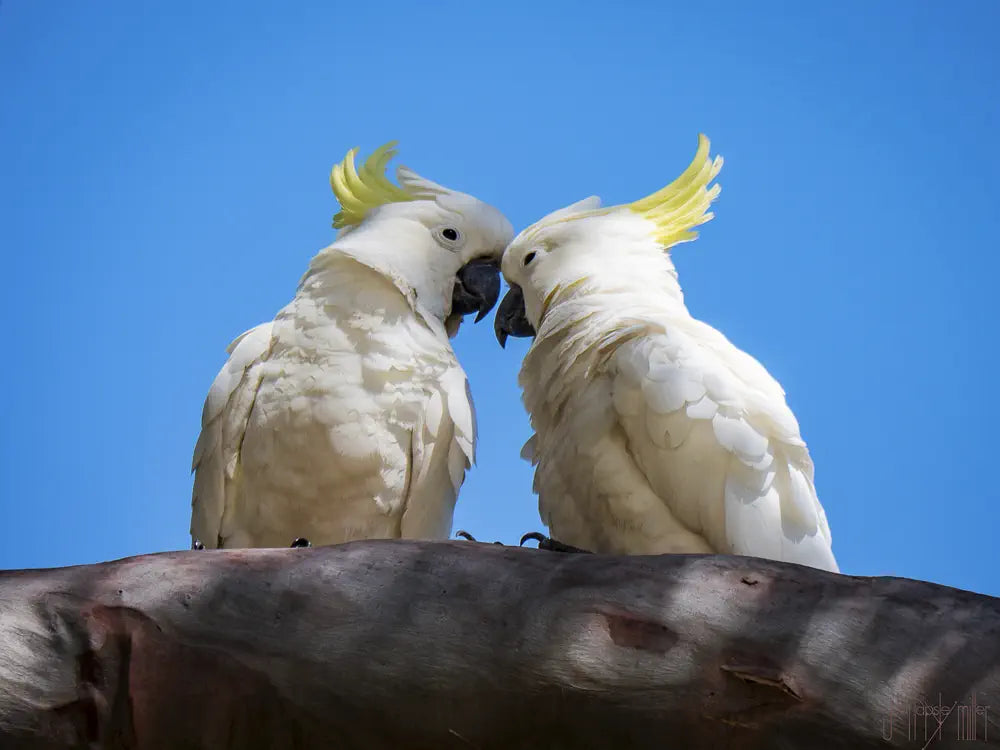
Birding across the ditch in Sydney
Share
Cockatoo #011 "Watermelon" (left) and partner enjoying a tender moment
For parrot-lovers, visiting Australia is always a treat! We recently visited Sydney for the first time and were delighted to see wild sulphur-crested cockatoos (Cacatua galerita) and rainbow lorikeets (Trichoglossus moluccanus) filling the skies with chatter and colour. It was quite something to see these beautiful birds outside of captivity.

Sulphur-crested cockatoo feeding on blossoms
My Aunty Helen was somewhat perplexed by our interest in what are commonly-seen birds to Sydneysiders, but she was very obliging in taking us to likely bird-watching sites around Mosman. I was particularly keen to see cockatoos.

Sulphur-crested cockatoo letting the world know who is boss
Having been involved in tracking the distribution of kākā around Wellington, I've followed the "Cockatoo Wingtag" program with interest (also see their Facebook page) - a joint venture between the University of Sydney and the Australian Museum. They too are interested in the distribution and behaviour of parrots in an urban setting and also rely on public reports to help track the birds. Unlike kākā, who just have coloured leg-bands, cockatoo have cattle-tags attached to their wings with large numbers written on them. This makes it much easier for the public to identify them as individuals without having to decipher leg-band colour combinations.
There are only around 100 birds in the Wingtag study, so we were not expecting to come across any, but to our delight, we spied not just one, but two Wingtag birds: #035 "Shakespeare" and #011 "Watermelon", both in Clifton Gardens in Mosman. (And yes, I had to just about leap out of a moving car to get the first sighting!)
As an aside, I do wonder if the yellow tags make the cockatoo more or less sexy to one another? Presumably the yellow tags were chosen to match their colouring?
There are only around 100 birds in the Wingtag study, so we were not expecting to come across any, but to our delight, we spied not just one, but two Wingtag birds: #035 "Shakespeare" and #011 "Watermelon", both in Clifton Gardens in Mosman. (And yes, I had to just about leap out of a moving car to get the first sighting!)
As an aside, I do wonder if the yellow tags make the cockatoo more or less sexy to one another? Presumably the yellow tags were chosen to match their colouring?

Cockatoo #035 "Shakespeare" sporting a leg band, two wing tags, and a solar-powered GPS unit.
Some cockatoo like Shakespeare are now also sporting solar-powered GPS units. Cockatoo are about twice the size of kākā so can carry the units more easily. When this was tried with kākā, the researchers were at the limit of what a bird could be expected to carry, plus the duller Wellington skies were not as conducive to solar-powered devices (battery-packs were more successful). Not to mention, it was incredibly difficult to build the units strong enough to withstand a kākā's powerful chomping beak. I hope they have more success than we did.

Helen reading the Sunday papers
Back home, I've been working on some compositions, including this one of Helen enjoying the Sunday papers, with some additional "embellishments" that for me capture what was a lovely long weekend "across the ditch".

Judi photographing an Aussie poser (photo by Linton Miller)
Linton also sneaked this shot of this "bird watching bird" scene - don't be surprised to see this charming kookaburra in a future composition!



